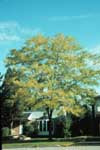 |
 |
|
A honey locust G. Lumis |
The leaf of a honey locust G. Lumis |
Scientific Name: Gleditsia triancanthos
Summary
Foliage: Deciduous broadleaf
Height: 30 to 70 feet
Spread: 30 to 50 feet
Shape: Spreading
Long compound leaves have little leaflets giving the foliage a lacy effect. Bright green foliage turns yellow in fall.
Plant Needs
Zone: 4 to 9
Light: Partial shade to full sun
Moisture: Wet, moist, or dry
Soil Type: Sandy, loam, or clay
pH Range: 4.5 to 7.3
Functions
Suggested uses for this plant include shade, street tree, massing, and specimen plant.
Planting Notes
Plant improved thornless, podless varieties. Easy to transplant because it withstands a wide range of conditions. Does best in moist bottomlands or soils with high pH. Prefers full sun. Extremely salt tolerant.
Care
Spray twice yearly to control webworms.
Click here to learn how to improve the soil.
Problems
Susceptible to mimosa webworms, leaf hoppers, spider mites, and leaf galls. Webworms are the worst problem, occasionally defoliating trees by August.
Alternatives
Consult local sources, including historic or public gardens and arboreta, regarding cultivars and related species that grow well in your area.
Cultivars of GLEDITSIA TRIACANTHOS
`Sunburst' has yellow new foliage which turns bright-green. It is seedless and podless.
`Shademaster' has ascending branches, dark green leaves. It is seedless and podless.
`Majestic' has nice dark-green foliage. It is seedless and podless.
Comments
Native Honey Locust trees are best known for their hazardous thorns and long, flat seed pods. Thornless, podless nursery varieties are highly recommended. Lacy foliage gives a loose, open shade ideal for patios and shade loving plants. In autumn, the small leaflets filter into the grass as they fall, requiring little raking.
This material was developed by Carol Ness as part of the Interactive Design and Development Project funded by the Kellogg Foundation. Mary Miller, Project Director. Diane Relf, Content Specialist, Horticulture. Copyright 1989 by VCE.

